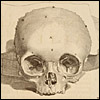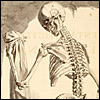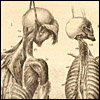
Beautiful Ugliness
Govard Bidloo and the Turn to Anatomical Realism
With Dutch anatomist Govard Bidloo, anatomical representation entered a new era. Some plates retained iconographical elements, but most were devoid of landscape, metaphor, and classicism. With high artistry, Bidloo flaunted his commitment to empirical observation and naturalistic depiction by showing what other anatomies omitted: the prosthetics of dissection (ropes, props, nails, chains) and the mutilation and ugliness of the dissected body. In producing such images, the anatomist claimed the power to appropriate, and cut into, dead human beings—and demonstrated a masterful clinical detachment, a privileged indifference to the horrors of the anatomy room.
Monumental
Books
Beautiful
Ugliness: Bidloo
Next
Topic: Another
Reality
Next Section: Visionary and Visible
U.S. National Library of Medicine, 8600 Rockville Pike, Bethesda, MD 20894
National Institutes of Health, Department of Health & Human Services
Copyright, Privacy, Accessibility
Last updated: 8 March 2004
|
Casting the Artist Aside: the anatomy of John Bell Scottish anatomist John Bell (1763-1820) condemned artists and their "vitious practice of drawing from imagination." There was, he insisted, a "continual struggle between the anatomist and the painter, one striving for elegance of form, the other insisting upon accuracy of representation." He solved the problem by drawing, etching and engraving his own illustrations. These challenged nearly every convention of anatomical representation. His dissected bodies and parts lack sumptuous texture and graceful line, and are unleavened by any palliative beauty. Their remarkable ugliness underscored his unyielding allegiance to tough-minded empirical observation. |



